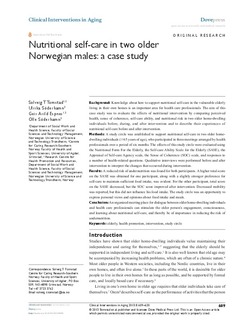| dc.description.abstract | Introduction: How to support nutritional self-care among older vulnerable individuals living in their own homes can be considered important knowledge for health care professionals. Aim: The aim of this case study was to evaluate the effects of a nutritional intervention by comparing self-reported perceived health, sense of coherence, self-care ability and nutritional risk in two older home-dwelling individuals before, during and after the intervention and also to describe experiences of nutritional self-care before and after the intervention. Methods: A study circle was established to support nutritional self-care in two older home-dwelling individuals (65+ years of age), who participated in three gatherings, arranged by health professionals, during a period of six months. The effects were evaluated with the instruments the Nutritional Form For the Elderly (NUFFE), the Self-care Ability Scale for the Elderly (SASE), the Appraisal of Self-care Agency (ASA) scale and the Sense of Coherence (SOC) scale and responses on a number of health related questions. Qualitative interviews were performed before and after the intervention to interpret changes that occurred during the intervention. Results: Reduced risk of undernutrition was obtained for both participants. Higher total score on SASE was obtained for one of the participants, and a slightly stronger preference to use the potential for self-care to maintain sufficient food intake and meals appeared. For the other participant, total score on SASE decreased, but SOC was stronger after the intervention. Decreased mobility was experienced, but did not influence the food intake. The study circle was an opportunity to bring in personal views and opinions about food intake and meals. Conclusion: An organized meeting place between older home-dwelling individuals and health care professionals, based upon dialogues, can stimulate the older person’s engagement, consciousness and learning about nutritional self-care, and be of importance to reduce risk of undernutrition. Key words: health, health promotion, intervention, study circle | nb_NO |
